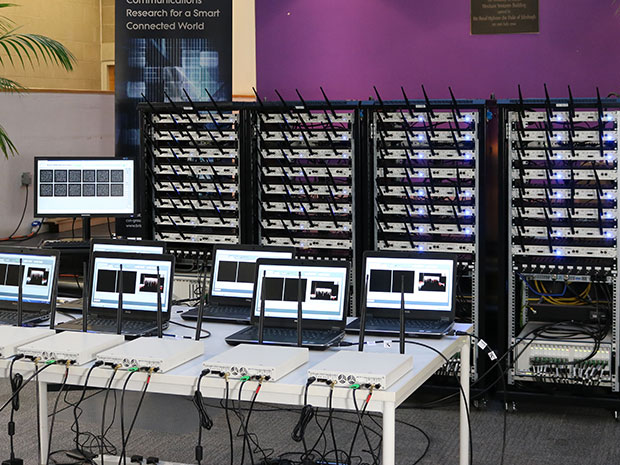A new world record has been set by a group of 5G researchers for spectrum efficiency. Their success with the massive MIMO (multiple-input, multiple outputs) assortments, which are cellular, structured stations compromising dozens antenna. It is also evidenced that such a technology is a favorable solution for wireless engineers working to create networks for delivering ultra-swift data speeds to a number of tablets and smartphones than before.
In a study the team attained a rate of 145.6 (bits/s) Hz for almost 22 users, each of them modulated with 256-QAM, on a joint 20 MHz radio channel with 128-antenna massive array at 3.51 GHz. It indicates a 22-fold boost in spectrum efficiency over the currently existing 4G networks.
The demonstration was concluded by eight postdocs and researchers from the university of Sweden and Bristol. The demonstration was on the upper level in the foyer of a university building on the campus of Bristol in England. This group was headed by Mark Beach, who is a radio system engineer at the Bristol University. “It is quite challenging to get things come together,” he says. “There are lots of things that need to happen to ensure the better working of the equipment, specifically – wires.”

With its new results, the group successfully beats its own record of 79.4 (bits/s) Hz for 12 users. The Bristol team has created an array that would perform efficiently as a unit of ultra-dense tiny cell networks in cities the firm is working on an enormous MIMO for a distinct purpose, which as a mode to transmit wireless the internet to rural regions from within the cities.
In the prospect years, users are expected to interchange more information over the instant data transmitting mechanism offered by 5G. But with users already experiencing a diminishing supply of spectrum, wireless engineers are required to find ways to utilize the existing spectrum for exchanging all this novel information more efficaciously without leading to delays for every person.
For achieving this, numerous groups emphasize on huge MIMO that permits the simultaneous transfer of multiple outgoing and incoming messages at one point of time. While the conventional cellular base locations might depend on signal processing for identifying the finest and rapid way to direct messages to their planned destinations.
Industry claims that it will need a 1000-fold boost in capacity for 5G to operate as envisioned. All of such increase may not come from gigantic MIMO, though – numerous other 5G technologies are in functionality such as beam forming and millimeter wave. Erik G. Larsson, who is the head of the Division of Communication Systems at the Linkoping University in Sweden, states that such massive results are experimental and not real-time. It is because these results were achieved in a completely controlled environment without any interference from the external cellular signals. Even the users were stationery, which is, in reality, is not the case.
Conclusion – For this demonstration, the team utilized a malleable prototyping platform from the National Instruments, which is created with LabVIEW PXI hardware and system design software.
Filed Under: News


Questions related to this article?
👉Ask and discuss on Electro-Tech-Online.com and EDAboard.com forums.
Tell Us What You Think!!
You must be logged in to post a comment.